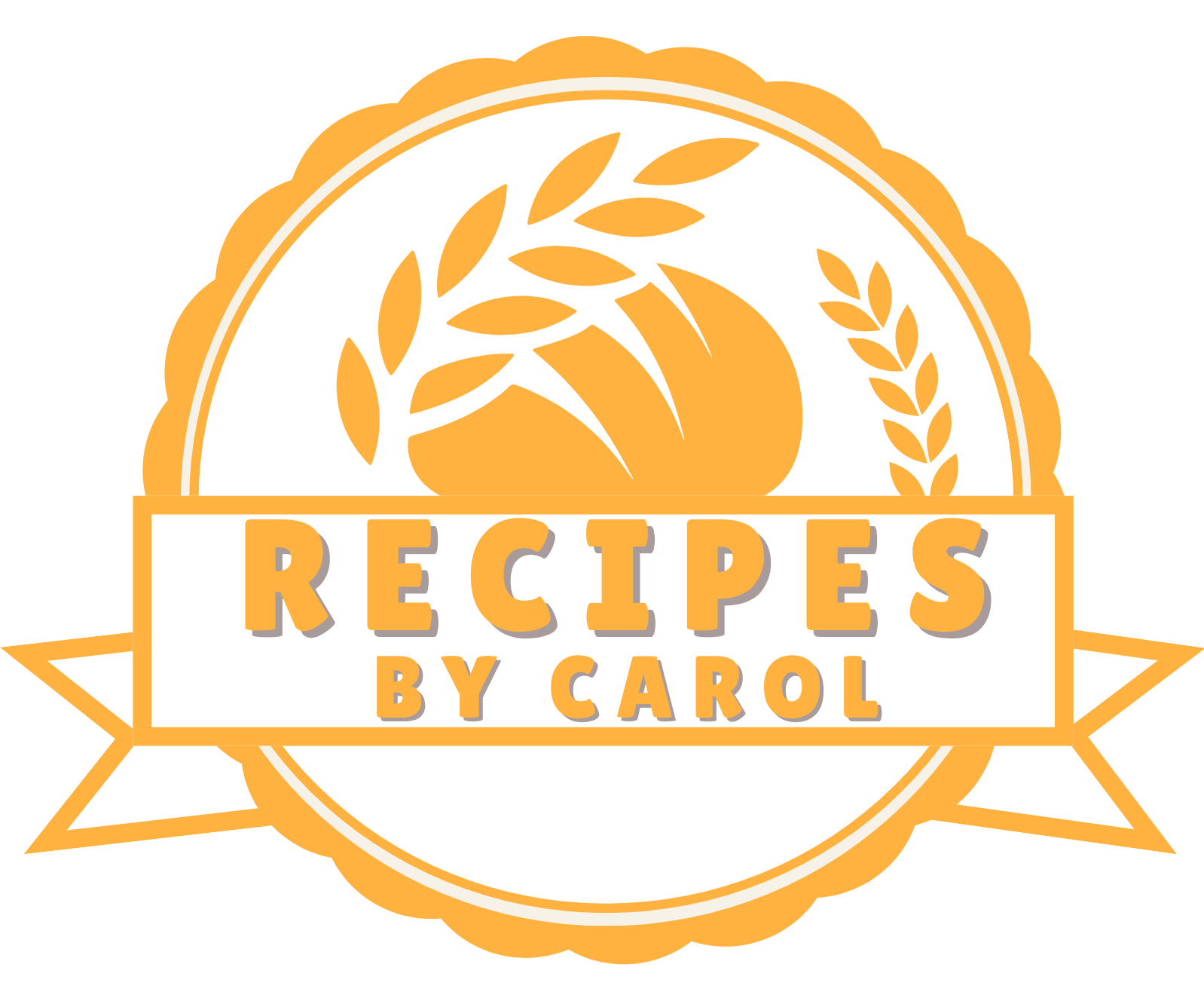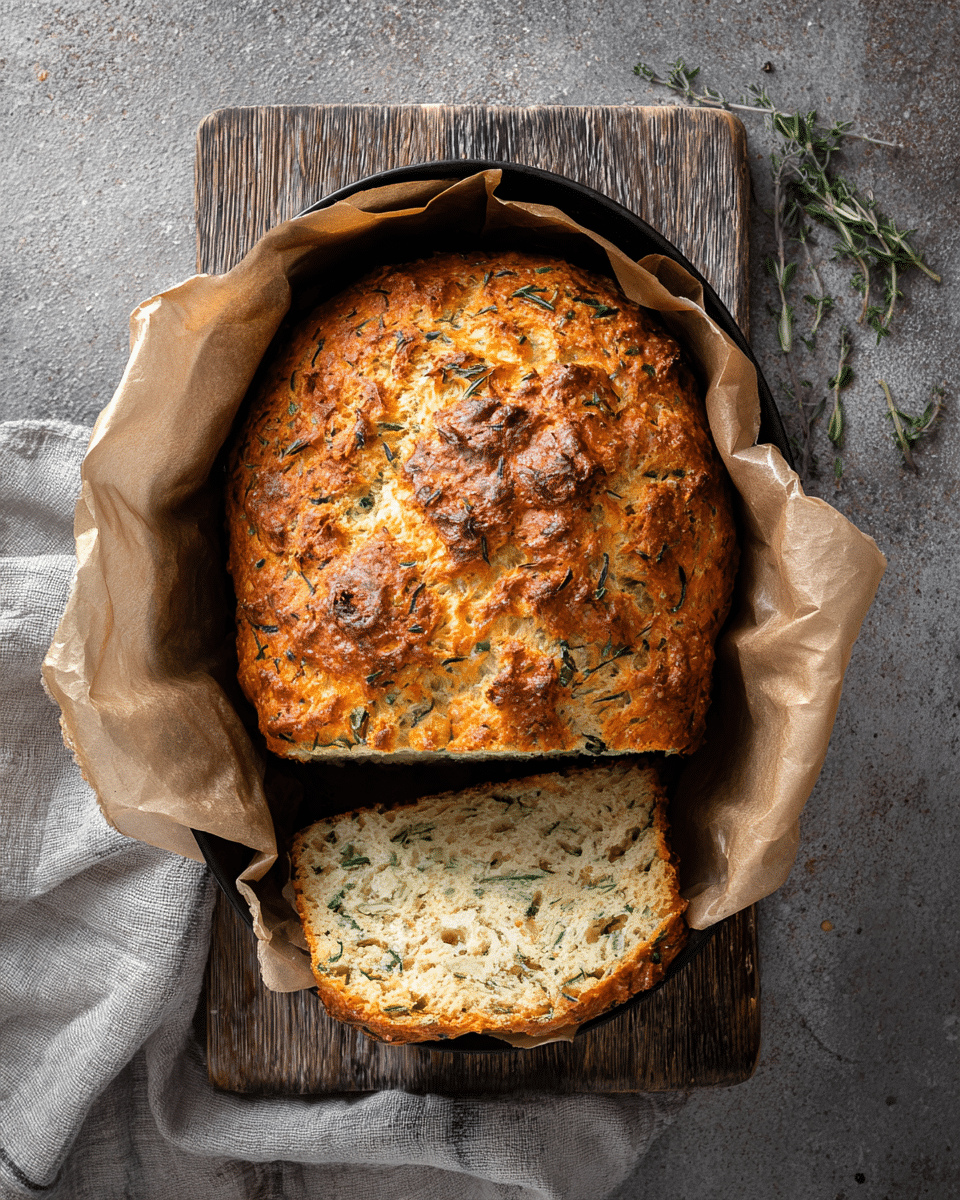This Cheese and Herb Irish Soda Bread is the kind of bake that makes your kitchen smell like pure comfort. The golden crust, infused with cheddar’s sharp richness, gives way to a tender crumb flecked with fresh herbs. Best of all it’s no knead, no yeast, and ready in under an hour, making it perfect for busy days or last minute gatherings.
Serve it warm, sliced thick, with generous pats of butter that melt into every nook. Pair it with hearty stews, creamy soups, or enjoy it on its own for a simple, satisfying treat. With its rustic charm and robust flavor, this soda bread brings a taste of Ireland to any table.
Full Recipe:
Ingredients:
-
4 cups all-purpose flour
-
1½ tsp baking soda (bicarbonate of soda)
-
1 tsp salt
-
2 cups (500ml) buttermilk
-
1 large egg
-
1 cup grated cheddar cheese
-
½ cup fresh herbs, chopped (parsley, sage, and chives recommended)
Directions:
-
Preheat oven to 180ºC/360ºF and line a Dutch oven or cast-iron pot with baking parchment.
-
In a large bowl, whisk together flour, baking soda, and salt.
-
Beat the egg into the buttermilk and pour into the dry ingredients.
-
Stir until the dough just begins to come together it should be shaggy, not smooth.
-
Gently fold in the cheese and herbs, mixing only until combined.
-
Shape the dough into a round and transfer to the prepared pot.
-
Score a cross on top with a sharp knife, cover with the lid, and bake for 30–45 minutes, until golden and hollow-sounding when tapped on the bottom.
-
Cool in the pot for 5–10 minutes, then transfer to a wire rack for another 15 minutes before slicing and serving warm with butter.
Prep Time: 10 minutes | Cooking Time: 45 minutes | Total Time: 55 minutes
Kcal: 296 kcal | Servings: 8
Cheese and Herb Irish Soda Bread – A Rustic Classic with a Savory Twist
Irish Soda Bread is one of those rare culinary treasures that is both humble and deeply satisfying. Its origins are steeped in tradition, yet it has adapted beautifully to modern kitchens. The cheese and herb variation elevates this staple, adding layers of rich flavor and aromatic freshness that make it irresistible. This version blends the simplicity of a quick bread with the indulgence of sharp cheddar and fragrant garden herbs transforming what is already a beloved classic into something extra special.
A Brief History of Irish Soda Bread
The origins of soda bread date back to the early 19th century when bicarbonate of soda became available in Ireland. Before that time, yeast was the traditional leavening agent for bread making, but yeast was not always easy to come by, particularly in rural areas. Soda bread offered an alternative that was faster, easier, and more reliable in Ireland’s damp climate.
The recipe relied on a simple chemical reaction between baking soda and acidic buttermilk to create carbon dioxide bubbles, giving the bread its lift. This meant the bread could be mixed, shaped, and baked in less than an hour a true gift for households without the time or means for lengthy proofing.
Traditionally, Irish soda bread was made with just four ingredients: flour, salt, baking soda, and buttermilk. It was often baked on a flat griddle or in a bastible pot (a cast-iron pot with a lid, used over an open fire) and marked with a deep cross on top. Folklore suggests that the cross was cut to ward off evil spirits, though in reality, it helped the bread cook evenly.
Adding Cheese and Herbs – A Modern Touch
While traditionalists might argue for keeping soda bread plain, the addition of cheese and herbs is a natural evolution. Cheddar cheese melts into the crumb, giving every bite a savory richness, while fresh herbs add brightness and complexity. This combination not only modernizes the bread but also makes it a versatile companion for a wide range of dishes.
Fresh parsley, sage, and chives are popular choices for their complementary flavors: parsley for freshness, sage for depth, and chives for a mild onion note. Other herbs like thyme, rosemary, or oregano work beautifully, and a mix of herbs can create a more layered flavor profile.
The Science of Soda Bread
One of the joys of Irish soda bread is its simplicity but behind that simplicity is some fascinating kitchen chemistry. In this bread, baking soda (an alkaline substance) reacts with the lactic acid in buttermilk. This reaction starts as soon as the wet and dry ingredients are combined, releasing carbon dioxide gas that lifts the dough.
Because the leavening process begins immediately, soda bread should be baked as soon as it’s mixed. Overmixing can cause too much gas to escape before baking, leading to a denser loaf. The goal is a dough that comes together quickly and retains its slightly shaggy, rustic texture.
Texture and Flavor
Cheese and herb soda bread is hearty and satisfying without being heavy. The crust is one of its defining features deeply golden and slightly crisp, offering a pleasing contrast to the tender, flavorful interior.
The crumb is moist and slightly dense compared to yeast-leavened breads, yet still light enough to make it perfect for sopping up broths or sauces. Cheddar adds a pleasant sharpness, while herbs infuse each slice with aromatic notes that evolve as you chew. Served warm, the cheese melts into pockets of molten goodness that enhance every bite.
Perfect Pairings
This bread’s savory profile makes it a natural side for hearty stews, soups, and roasted meats. A few ideal pairings include:
-
Irish Lamb Stew – The robust flavors of lamb, root vegetables, and herbs are complemented perfectly by the bread’s cheesy, herby notes.
-
Creamy Potato Soup – The bread’s crustiness and slight tang balance the creaminess of the soup.
-
Slow-Braised Beef Short Ribs – Use thick slices to soak up the rich gravy.
-
Hearty Salads – Serve wedges alongside green salads or grain salads for a rustic, satisfying lunch.
It’s also delicious simply toasted with butter, drizzled with olive oil, or topped with a fried egg for breakfast.
Serving Tips
To enjoy it at its best, soda bread should be eaten fresh preferably the day it’s made. While it will last a few days if wrapped in wax paper and foil, the crust will lose its initial crispness. Slightly stale slices can be revived by toasting, which brings back some of the original texture.
This bread also freezes well. Wrap it tightly in foil and place it in a freezer-safe bag. Thaw at room temperature and warm in the oven before serving.
Variations to Try
Once you’ve mastered the base cheese and herb version, there’s plenty of room to experiment:
-
Different Cheeses – Try Gruyère, Fontina, or a sharp aged Gouda for unique flavor twists.
-
Add Garlic – Roasted garlic cloves folded into the dough add sweetness and depth.
-
Sun-Dried Tomatoes – For a Mediterranean flair, chop and fold them in with the cheese.
-
Seeded Crust – Sprinkle sesame or poppy seeds on top before baking for added crunch.
-
Smoky Version – Add smoked cheddar or paprika for a warming, earthy note.
Why This Bread Works for All Skill Levels
One of the greatest appeals of soda bread especially this cheese and herb version is its accessibility. It requires no yeast, no proofing time, and no special equipment beyond a baking sheet or Dutch oven. This makes it ideal for beginners intimidated by traditional bread-making.
At the same time, experienced bakers love it for its versatility and speed. It’s a perfect last-minute solution when you realize you need fresh bread for dinner but don’t have hours to spare.
Cultural Significance Today
Although soda bread is often associated with St. Patrick’s Day celebrations outside of Ireland, in its home country it’s a year-round staple. The cheese and herb variation speaks to a broader trend of celebrating tradition while embracing innovation. It’s a nod to Ireland’s past but also a reflection of contemporary culinary creativity.
In an age where slow food movements are gaining popularity, soda bread stands as an example of a “slow” experience with “fast” preparation made from scratch, free from preservatives, yet ready in under an hour.
Tips for the Best Results
While this isn’t a step-by-step guide, there are some key points to keep in mind:
-
Use fresh, good-quality cheese and herbs for maximum flavor.
-
Handle the dough gently; overmixing will make it tough.
-
Bake it soon after mixing to take advantage of the leavening reaction.
-
Scoring the top not only looks attractive but helps the loaf bake evenly.
A Comfort Bake with Timeless Appeal
In many ways, cheese and herb Irish soda bread is the embodiment of what comfort food should be: deeply satisfying, unfussy, and easy to share. Whether you’re making it for a family meal, a holiday celebration, or simply to enjoy with a pot of soup, it brings warmth to the table and smiles to those who taste it.
Its rustic charm lies in its imperfections the slightly uneven crust, the speckled crumb, the way the cheese creates molten pockets in some slices but not others. It’s honest food, made with simple ingredients, yet capable of creating lasting food memories.
Conclusion:
Cheese and herb Irish soda bread bridges the gap between old-world tradition and modern flavor. It honors the simplicity of the original recipe while offering a richer, more aromatic experience. In less than an hour, you can go from mixing bowl to table, filling your home with the smell of baking bread and your plate with something warm, crusty, and utterly satisfying.
Whether you serve it alongside a classic Irish stew, enjoy it as a midday snack, or gift it to a friend, this bread proves that great baking doesn’t need to be complicated. It’s a recipe worth keeping in your repertoire not just for St. Patrick’s Day, but for any day you want to bring a little rustic comfort to your kitchen.






